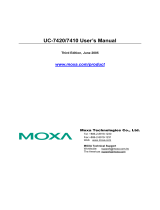
MC-1100 Series Linux Software UM Software Configuration
sysfs on /sys type sysfs (rw,nosuid,nodev,noexec,relatime)
proc on /proc type proc (rw,nosuid,nodev,noexec,relatime)
udev on /dev type devtmpfs (rw,relatime,size=10240k,nr_inodes=492181,mode=755)
devpts on /dev/pts type devpts
(rw,nosuid,noexec,relatime,gid=5,mode=620,ptmxmode=000)
tmpfs on /run type tmpfs (rw,nosuid,relatime,size=790820k,mode=755)
/dev/sda1 on / type ext4 (rw,noatime,errors=remount-ro,data=ordered)
securityfs on /sys/kernel/security type securityfs
(rw,nosuid,nodev,noexec,relatime)
tmpfs on /dev/shm type tmpfs (rw,nosuid,nodev)
tmpfs on /run/lock type tmpfs (rw,nosuid,nodev,noexec,relatime,size=5120k)
tmpfs on /sys/fs/cgroup type tmpfs (ro,nosuid,nodev,noexec,mode=755)
cgroup on /sys/fs/cgroup/systemd type cgroup
(rw,nosuid,nodev,noexec,relatime,xattr,release_agent=/lib/systemd/systemd-cgrou
ps
-agent,name=systemd)
pstore on /sys/fs/pstore type pstore (rw,nosuid,nodev,noexec,relatime)
cgroup on /sys/fs/cgroup/cpuset type cgroup
(rw,nosuid,nodev,noexec,relatime,cpuset)
cgroup on /sys/fs/cgroup/cpu,cpuacct type cgroup
(rw,nosuid,nodev,noexec,relatime,cpu,cpuacct)
cgroup on /sys/fs/cgroup/devices type cgroup
(rw,nosuid,nodev,noexec,relatime,devices)
cgroup on /sys/fs/cgroup/freezer type cgroup
(rw,nosuid,nodev,noexec,relatime,freezer)
cgroup on /sys/fs/cgroup/net_cls,net_prio type cgroup
(rw,nosuid,nodev,noexec,relatime,net_cls,net_prio)
cgroup on /sys/fs/cgroup/blkio type cgroup (rw,nosuid,nodev,noexec,relatime,blkio)
cgroup on /sys/fs/cgroup/perf_event type cgroup
(rw,nosuid,nodev,noexec,relatime,perf_event)
tmpfs on /etc/machine-id type tmpfs (ro,relatime,size=790820k,mode=755)
systemd-1 on /proc/sys/fs/binfmt_misc type autofs
(rw,relatime,fd=21,pgrp=1,timeout=300,minproto=5,maxproto=5,direct)
hugetlbfs on /dev/hugepages type hugetlbfs (rw,relatime)
mqueue on /dev/mqueue type mqueue (rw,relatime)
debugfs on /sys/kernel/debug type debugfs (rw,relatime)
binfmt_misc on /proc/sys/fs/binfmt_misc type binfmt_misc (rw,relatime)
/dev/sdb1 on /media/usb0 type vfat
(rw,nodev,noexec,noatime,nodiratime,sync,fmask=0022,dmask=0022,codepage=437,ioc
ha
rset=utf8,shortname=mixed,errors=remount-ro)
/dev/sdc1 on /media/usb1 type vfat
(rw,nodev,noexec,noatime,nodiratime,sync,fmask=0022,dmask=0022,codepage=437,ioc
ha
rset=utf8,shortname=mixed,errors=remount-ro)
ATTENTION
Remember to type the command #
sync
before you disconnect the USB storage device. If you do not issue the
command, you may lose data.

























